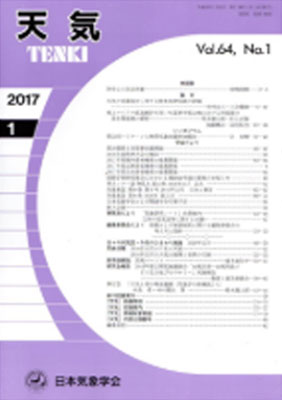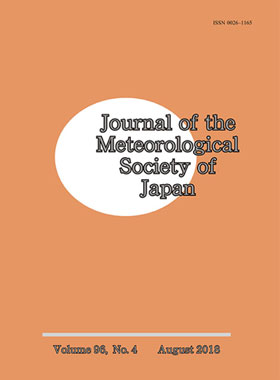How to Submit
Before submitting your manuscript, please read through the entire Guide to Authors and prepare your manuscripts according to the instructions. Manuscripts must then be submitted via the journal’s ScholarOne system at https://mc.manuscriptcentral.com/sola. Instructions and user tutorials for the use of ScholarOne are available on the submission page.
Should you have any questions, please contact the SOLA Chief Editor:
Dr. Tetsuya Takemi
Chief Editor of SOLA
Disaster Prevention Research Institute
Kyoto University
Gokasho, Uji, Kyoto 611-0011, Japan
E-mail: sola_edit@metsoc.or.jp
Tel: +81-774-38-4160, Fax: +81-774-38-4158
SOLA manuscripts format
License to Publish form: https://mc.manuscriptcentral.com/societyimages/sola/LTP_SOLA.pdf
ARTICLE TYPES AND ARTICLE PREPARATION
SOLA publishes Regular Articles, which are generally shorter, letter-style articles within a maximum word count of 3100 and a maximum total of 7 figures and tables. Authors can determine the structure of the manuscript’s main text (see below for more details).
Corrections (Corrigenda and Retractions) are published when justified. Authors who would like to submit a Corrigendum should contact the SOLA Chief Editor and see the ‘Corrigenda and Retractions’ section for more details.
A sample style file for each article type can be obtained from the SOLA ScholarOne webpage (https://mc.manuscriptcentral.com/sola).
Cover letter
The manuscripts must be submitted with a cover letter that contains the title, author name(s), affiliations, telephone and fax numbers, and e-mail address of the corresponding author (https://mc.manuscriptcentral.com/societyimages/sola/Sample-Cover-Letter.doc). A short paragraph on the manuscript’s suitability for the journal is useful.
Authors may specify names of at least one appropriate Editor in charge of their manuscript and are required to specify names of 3–5 potential reviewers and their e-mail addresses when submitting the manuscripts through the ScholarOne submission system.
Requests for waivers of the Article Processing Charge (APC) should be made in the cover letter. See the Open Access section for more details on the journal’s APC waiver policy.
If the manuscript is a resubmission of a previously rejected paper in SOLA, the cover letter should include the manuscript number of the previous submission. In this case, please include point-by-point responses to the reviewers’ comments in the previous submission. The Chief Editor will evaluate the suitability of the resubmission and may assign the same Editor from the previous submission.
English standard
All manuscripts must be written in clear and concise English. Those not reaching the required standard may be returned to authors for further revision.
Format
Regular Articles should include the main text, figures, tables (if any), a cover letter, and the License to Publish form, signed by all authors. The License to Publish form can also be sent separately via e-mail to the address of the SOLA Editorial Office (sola_edit@metsoc.or.jp).
The main text must be a double-spaced Microsoft Word (".docx" format is recommended) or PDF file with line numbers on the left side of the pages. The main text should include, in this order: the title, the author names and affiliation(s), Abstract, main text in appropriately divided sections, Acknowledgements, Supplementary Material (if required), and the References. We strongly recommend using the relevant template file, which can be found at the “Instruction & Forms” link at the SOLA ScholarOne webpage (https://mc.manuscriptcentral.com/sola).
Word limit
The main text must be less than 3100 words at the time of submission, including the abstract and the main body of the manuscript. Note that the title, author names and affiliations, Acknowledgements, description of the Supplementary Material, References, figure captions and words within Supplementary Materials are not included in the word limit. The total number of figures and tables must not exceed seven.
Manuscripts exceeding the word limit and/or the total number of figures and tables will be returned to authors without review by the SOLA Editorial Office.
At the time of acceptance (the final version of the manuscript), the maximum word count is permitted up to 3500 (which includes the abstract and the main body of the manuscript), in order to allow the authors to incorporate revisions during the review process. Note that the limitation of the total number of figures and tables combined applies to the final version of the manuscript.
Title, author names and affiliations
An informative title that is attractive to the journal’s readers should be provided. The full names and affiliations of all authors, and the name, e-mail address, telephone and fax numbers of the corresponding author should be provided.
Abstract
A short abstract of 200 words or less is required with each manuscript.
Text
The text should be divided into sections, each with a separate heading and numbered consecutively. The section heading should be written on a separate line, e.g.,
1. Section
1.1 Subsection
a. Item
(1) ···
(i) ··· .
Mathematical formulas and equations should be written clearly in the text with ample space above and below.
Running title
The running title should encapsulate the article and not exceed 10 words.
Acknowledgements
The Acknowledgements section should include individuals who qualify as substantial contributors to the paper, but do not meet the criteria for authorship. The funding sources (including grant numbers) should also be included.
Supplementary Material
Up to 5 items of Supplementary Material, such as large figures and animations, can be included. Each item of material should be numbered sequentially and specified in the text for where appropriate. The maximum allowance is 50 MB for each item. The author(s) may link outside source data (figures, movies, and big data, etc.) from the Supplementary Material. The authors should briefly describe the contents of the items in this section.
References
References should be arranged alphabetically by authors’ names, without numbering. For example, the citation of references should be as “according to Rossby (1940)” or “as shown by earlier studies (Rossby 1945; Charney 1947).” In the list of references, each reference must be complete in the following form:
For a journal article: author(s), year: title of article. title of journal (abbreviated), volume number, pages.
- Kobayashi, S., Y. Ota, Y. Harada, A. Ebita, M. Moriya, H. Onoda, K. Onogi, H. Kamahori, C. Kobayashi, H. Endo, K. Miyaoka, and K. Takahashi, 2015: The JRA-55 Reanalysis: General specifications and basic characteristics. J. Meteor. Soc. Japan, 93, 5–48.
- Yatagai, A., O. Arakawa, K. Kamiguchi, H. Kawamoto, M. I. Nodzu, and A. Hamada, 2009: A 44-year daily gridded precipitation dataset for Asia based on a dense network of rain gauges. SOLA, 5, 137–140, doi:10.2151/sola.2009-035.
For a journal article in press with DOI or article without pages but with DOI:
- Takemi, T., 2019: A template file to prepare the SOLA manuscript. SOLA, 15, in press, doi:10.2151/sola.2019-xyz.
For a book: author(s), year: title of book. publisher, page.
- Holton, J. R., and G. J. Hakim, 2012: An Introduction to Dynamic Meteorology, Fifth Edition. Academic Press, 552 pp.
For a web page: author(s)/organization, year: name of the page (DOI or URL, date accessed)
- Cabinet Office, 2018: A report on damages by Typhoon Jebi (2018). The version of 2 October 2018. (Available online at: http://www.bousai.go.jp/updates/h30typhoon21/pdf/301003_typhoon21_01.pdf, accessed 20 November 2018)
Figures and tables
The maximum total number of figures and tables is 7. You can use the Supplementary Material to display additional figures and tables, if you would like to show in excess of the total allowable number.
Upon submission, each figure and table can be prepared separately or can be included within a single file. Separate figure files will be required if the manuscript is accepted for publication. The resolution of figures and tables should be above 300 dpi. The following formats are acceptable for figure and/or table files: TIFF, GIF, JPEG, AI, EPS, and PSD. If your manuscript is accepted, the Editorial Office will request separate files for the production process.
If you prepare your figure/table files separately, you should upload them in numerical order to the SOLA ScholarOne system. In this case, the legends of the figures and tables must be provided in the text box on the figure upload page.
Figure and table legends
To help the Editor and the reviewers evaluate your manuscript, each figure or table must be provided with a cogent and succinct legend that allows it to stand alone.
Figures: Each figure should be mentioned specifically in the text. Lettering must be large enough to remain clearly legible when reduced to the journal’s column width. Color figures are welcome.
Supplementary Materials: Authors are encouraged to effectively use this function of SOLA in order to enrich or supplement the contents of the main text. Examples are detailed descriptions of the methods used in the study, supplementary figures/tables/animations, and sample codes for numerical simulations, or data analyses.



 RSS feed of SOLA latest issue
RSS feed of SOLA latest issue
